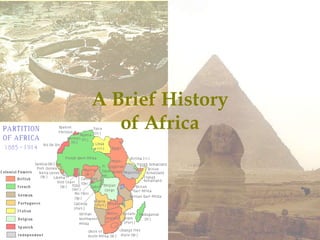africa-history.ppt
•Download as PPT, PDF•
0 likes•10 views
- Lucy, discovered in Ethiopia in 1974, was a 3.2 million year old ancestor of humans who migrated from Africa to Asia. - Ancient Egypt developed along the Nile River beginning around 7,000 BC, establishing agriculture, government, religion, and writing. They built pyramids and controlled the flooding of the Nile. - Beginning around 1000 BC, the Bantu people migrated out of Nigeria, conquering with iron weapons and spreading their language, agriculture, and ironworking throughout central and southern Africa.
Report
Share
Report
Share

Recommended
Recommended
More Related Content
Similar to africa-history.ppt
Similar to africa-history.ppt (20)
Recently uploaded
Antibiotics are medicines that fight infections caused by bacteria in humans and animals by either killing the bacteria or making it difficult for the bacteria to grow and multiply. Bacteria are germsABHISHEK ANTIBIOTICS PPT MICROBIOLOGY // USES OF ANTIOBIOTICS TYPES OF ANTIB...

ABHISHEK ANTIBIOTICS PPT MICROBIOLOGY // USES OF ANTIOBIOTICS TYPES OF ANTIB...ABHISHEK SONI NIMT INSTITUTE OF MEDICAL AND PARAMEDCIAL SCIENCES , GOVT PG COLLEGE NOIDA
Recently uploaded (20)
Efficient spin-up of Earth System Models usingsequence acceleration

Efficient spin-up of Earth System Models usingsequence acceleration
Cyathodium bryophyte: morphology, anatomy, reproduction etc.

Cyathodium bryophyte: morphology, anatomy, reproduction etc.
ABHISHEK ANTIBIOTICS PPT MICROBIOLOGY // USES OF ANTIOBIOTICS TYPES OF ANTIB...

ABHISHEK ANTIBIOTICS PPT MICROBIOLOGY // USES OF ANTIOBIOTICS TYPES OF ANTIB...
Cot curve, melting temperature, unique and repetitive DNA

Cot curve, melting temperature, unique and repetitive DNA
TransientOffsetin14CAftertheCarringtonEventRecordedbyPolarTreeRings

TransientOffsetin14CAftertheCarringtonEventRecordedbyPolarTreeRings
Use of mutants in understanding seedling development.pptx

Use of mutants in understanding seedling development.pptx
Thyroid Physiology_Dr.E. Muralinath_ Associate Professor

Thyroid Physiology_Dr.E. Muralinath_ Associate Professor
GBSN - Biochemistry (Unit 2) Basic concept of organic chemistry 

GBSN - Biochemistry (Unit 2) Basic concept of organic chemistry
development of diagnostic enzyme assay to detect leuser virus

development of diagnostic enzyme assay to detect leuser virus
FAIRSpectra - Enabling the FAIRification of Analytical Science

FAIRSpectra - Enabling the FAIRification of Analytical Science
X-rays from a Central “Exhaust Vent” of the Galactic Center Chimney

X-rays from a Central “Exhaust Vent” of the Galactic Center Chimney
LUNULARIA -features, morphology, anatomy ,reproduction etc.

LUNULARIA -features, morphology, anatomy ,reproduction etc.
Human & Veterinary Respiratory Physilogy_DR.E.Muralinath_Associate Professor....

Human & Veterinary Respiratory Physilogy_DR.E.Muralinath_Associate Professor....
Module for Grade 9 for Asynchronous/Distance learning

Module for Grade 9 for Asynchronous/Distance learning
africa-history.ppt
- 1. A Brief History of Africa
- 2. Origins of Humankind • “Lucy” – 3.2 million years old • Ancestor of true man • Migrated to Asia
- 3. Lucy
- 4. Lucy
- 5. Ancient Egypt • Built around Nile River – 7,000 b.c. • Free movement of people: a. Spread Egyptian ideas b. Aided in development c. Expansion of empire • Improved agricultural techniques – food surplus • Develop gov’t, religion & writing
- 6. Ancient Egypt cont. • Agriculture & trade • Pharaohs (Kings) a. Control 3100 – 1000 b.c. b. Pyramids c. Control Nile’s flooding • Sahara becomes desert --- Nile now major trade route
- 7. Bantu Migration • Nigeria • Migrate out a. Overpopulation b. Slash & burn farming • Conquer with iron weapons • Important a. Central to development b. Spread Niger-Congo language, agriculture & iron-working
- 8. Kingdoms: West Africa • Ghana, Mali & Songhai • Factoids 1. Gold 2. Islam (brought by traders) 3. Use of slave labor or sold slaves for $$
- 9. Kingdoms: South Africa • Great Zimbabwe • Bantu • Built a large city w/ huge walls • Significance a. Trade b. Architecture
- 10. Europeans Arrive • Trade on Mediterranean Coast • Portugal, Britain & Netherlands -15th century – coastal areas - Why? Gold, route to India, Christianity -Later, slave trade
- 11. Slave Trade • Common practice • Took slaves when conquering neighboring tribes
- 12. Triangular Trade • Slave trade expands w/ Europeans • West Africa to Colonies to Europe • 10 – 20 million slaves • Effects 1. Broke up families 2. Deplete population in rural areas 3. Destroys villages
- 13. Middle Passage • Trip from Africa to colonies • Last up to 6 months • Packed in (18 in. space) Disease spreads easily Chained together
- 14. End of Slave Trade • Opposition b/c of ethics & morals • Industrial Revolution – products more valuable • Europe & U.S. abolish trade by early 1800s • Slavery remains legal (Some trade continues on the sly)
- 15. Prior to Whitey
- 16. Imperialism Partition • Berlin Conference (1884) “Scramble for Africa” • Ground rules for gaining territory – respect each others space
- 17. Imperialism cont. Purposes • Power (Land = power) • Strategic waterways • Resources for industry • Spread Christianity – civilize the natives • Settlements – move natives into poor land
- 18. Effects of Imperialism • Cultural 1. Create borders with no regard to ethnicities (Combine enemies & separate allies) 2. Centralized gov’t 3. Oppression • Economy 1. Loss of resources 2. Neglected infrastructure ***Root cause of the violence today!!!!
- 19. Desire for Independence • Resent European presence • Inequalities of colonialism – treated as 2nd class • World Wars opened eyes to racism in Africa • WWII drained many European powers • Most countries gain independence by 1975